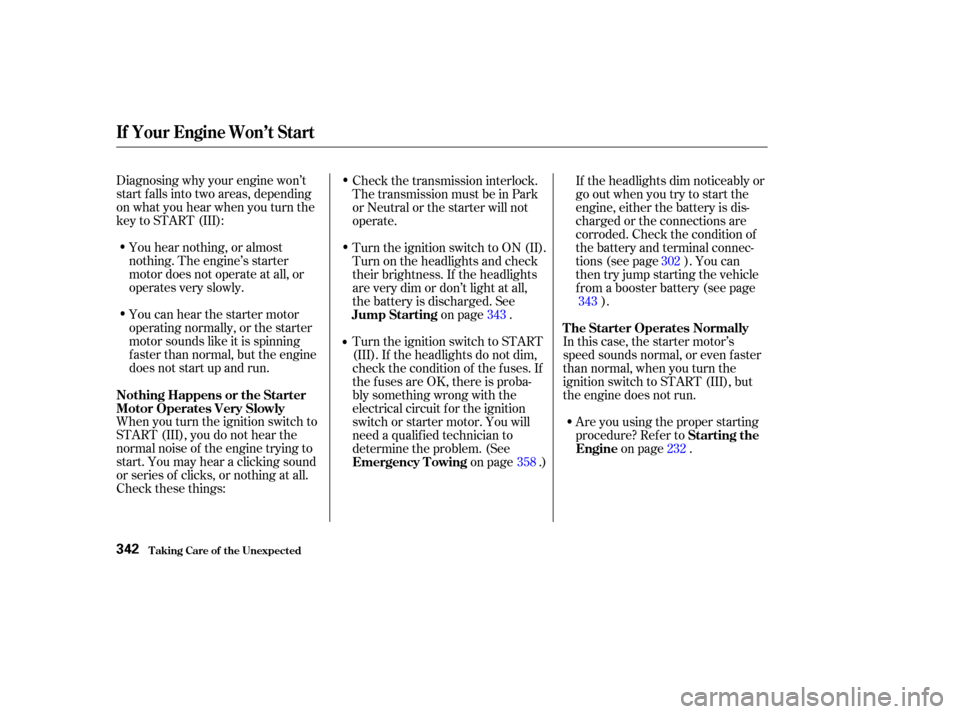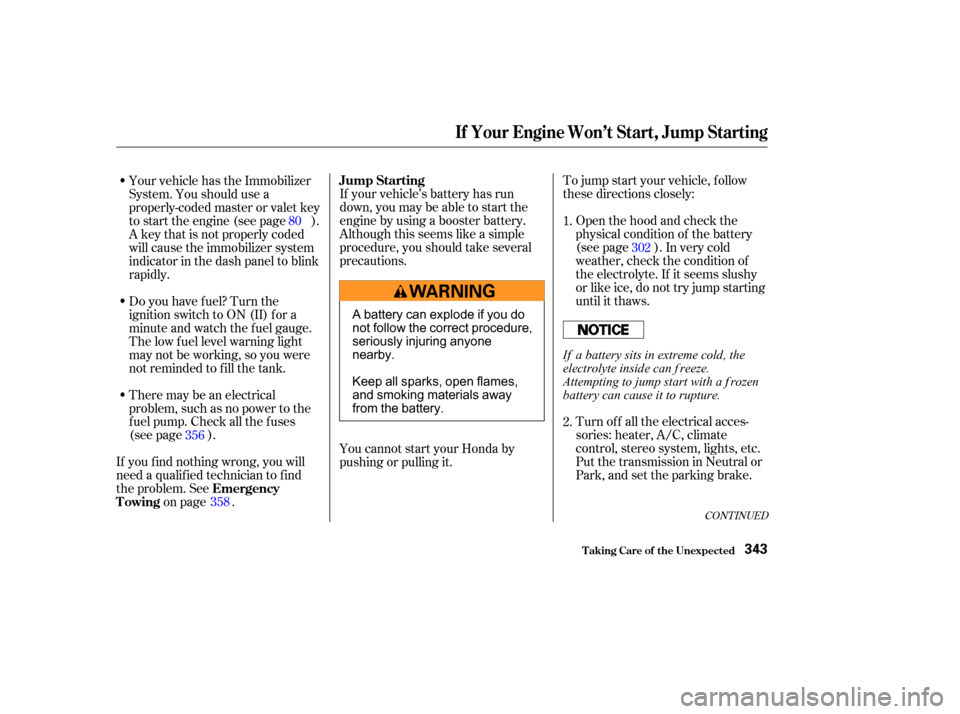Page 346 of 392

Diagnosing why your engine won’t
start f alls into two areas, depending
on what you hear when you turn the
key to START (III):You hear nothing, or almost
nothing. The engine’s starter
motor does not operate at all, or
operates very slowly.
You can hear the starter motor
operating normally, or the starter
motor sounds like it is spinning
f aster than normal, but the engine
does not start up and run.
When you turn the ignition switch to
START (III), you do not hear the
normal noise of the engine trying to
start. You may hear a clicking sound
or series of clicks, or nothing at all.
Check these things: Check the transmission interlock.
The transmission must be in Park
orNeutralorthestarterwillnot
operate.
Turn the ignition switch to ON (II).
Turn on the headlights and check
their brightness. If the headlights
are very dim or don’t light at all,
the battery is discharged. See
on page .
Turn the ignition switch to START
(III). If the headlights do not dim,
check the condition of the f uses. If
thefusesareOK,thereisproba-
bly something wrong with the
electrical circuit for the ignition
switch or starter motor. You will
need a qualif ied technician to
determine the problem. (See on page .)If the headlights dim noticeably or
go out when you try to start the
engine, either the battery is dis-
charged or the connections are
corroded. Check the condition of
the battery and terminal connec-
tions (see page ). You can
then try jump starting the vehicle
f rom a booster battery (see page
).
In this case, the starter motor’s
speed sounds normal, or even f aster
than normal, when you turn the
ignition switch to START (III), but
the engine does not run. Are you using the proper starting
procedure? Ref er to on page .
343
358 302
343
232
Nothing Happens or the Starter
Motor Operates Very Slowly Jump Starting
Emergency T owingT he Starter Operates Normally
Starting the
Engine
T aking Care of t he Unexpect ed
If Your Engine Won’t Start
342
Page 347 of 392

To jump start your vehicle, f ollow
these directions closely:
If your vehicle’s battery has run
down,youmaybeabletostartthe
engine by using a booster battery.
Although this seems like a simple
procedure, you should take several
precautions.
Put the transmission in Neutral or
Park, and set the parking brake. Open the hood and check the
physical condition of the battery
(see page ). In very cold
weather, check the condition of
the electrolyte. If it seems slushy
or like ice, do not try jump starting
until it thaws.
Turn of f all the electrical acces-
sories: heater, A/C, climate
control, stereo system, lights, etc.
Your vehicle has the Immobilizer
System. You should use a
properly-coded master or valet key
to start the engine (see page ).
A key that is not properly coded
will cause the immobilizer system
indicator in the dash panel to blink
rapidly.
Do you have f uel? Turn the
ignition switch to ON (II) for a
minute and watch the f uel gauge.
The low f uel level warning light
may not be working, so you were
not reminded to f ill the tank.
There may be an electrical
problem, such as no power to the
f uel pump. Check all the f uses
(see page ).
If youfindnothingwrong,youwill
need a qualif ied technician to f ind
the problem. See on page . You cannot start your Honda by
pushing or pulling it. 1.
2.
80
356 358 302
CONT INUED
Jump Starting
Emergency
Towing
If Your Engine Won’t Start, Jump Starting
T aking Care of t he Unexpect ed343
A battery can explode if you do
not follow the correct procedure,
seriously injuring anyone
nearby.
Keep all sparks, open flames,
and smoking materials away
from the battery. If a battery sits in extreme cold, the
electrolyte inside can f reeze.
Attempting to jump start with a f rozen
battery can cause it to rupture.
Page 348 of 392
�µ
�´
�´
Start your vehicle. If the starter
motor still operates slowly, check
the jumper cable connections to
make sure they have good metal-
to-metal contact.
Once your vehicle is running,
disconnect the negative cable f rom
your vehicle, then f rom the
booster battery. Disconnect the
positive cable f rom your vehicle,
then the booster battery.
Connect the second jumper cable
to the negative ( ) terminal on
the booster battery. Connect the
other end to the grounding strap
as shown. Do not connect this
jumper cable to any other part of
the engine. The numbers in the illustration show
you the order to connect the jumper
cables.
If the booster battery is in another
vehicle, have an assistant start
that vehicle and run it at a fast idle.
Connect one jumper cable to the
positive ( ) terminal on your
Honda’s battery. Connect the
other end to the positive ( )
terminal on the booster battery. 5.
7.
3.
4.
6.
T aking Care of t he Unexpect ed
Jump Starting
344
BOOSTER BATTERY
Page 352 of 392
This indicator should come on when
the ignition switch is ON (II), and go
out af ter the engine starts. If it
comes on brightly when the engine
is running, it indicates that the
charging system has stopped
charging the battery.By eliminating as much of the
electrical load as possible, you can
drive several miles (kilometers)
before the battery is too discharged
to keep the engine running. Drive to
a service station or garage where
you can get technical assistance.
Immediately turn of f all electrical
accessories:radio,heater,A/C,
climate control, rear def ogger, cruise
control, etc. Try not to use other
electrically-operated controls such as
the power windows. Keep the engine
running and take extra care not to
stall it. Starting the engine will
discharge the battery rapidly.
T aking Care of t he Unexpect ed
Charging System Indicator
348
CHARGING SYSTEM INDICATOR
Page 354 of 392
If possible, do not take your vehicle
f or a state emissions test until the
readiness codes are set. To check if
they are set, turn the ignition ON (II),
but do not start the engine. The
Malf unction Indicator Lamp will
come on f or 20 seconds. If it then
goes of f , the readiness codes are set.
If it blinks 5 times, the readiness
codes are not set. Ref er to State
Emissions Testing f or more
inf ormation.(See page .)
Your vehicle has certain ‘‘readiness
codes’’ that are part of the on-board
diagnostics f or the emissions
systems. In some states, part of the
emissions testing is to make sure
these codes are set. If they are not
set, the test cannot be completed.
If your vehicle’s battery has been
disconnected or gone dead, these
codes are erased. It takes several
days of driving under various
conditions to set the codes again.
371
T aking Care of t he Unexpect ed
Malf unction Indicator L amp
Readiness Codes
350
Page 357 of 392
If something electrical in your
vehicle stops working, the first thing
youshouldcheckforisablownfuse.
Determine f rom the chart on pagesand , or the diagram on the
f use box lid (the diagram f or the
driver’s side interior f use box is on
the kick panel below the f use box),
which f use or f uses control that
component. Check those f uses f irst,
but check all the f uses bef ore
deciding that a blown f use is not the
cause. Replace any blown f uses and
check the component’s operation.
Turn the ignition switch to LOCK
(0). Make sure the headlights and
all other accessories are off.
Remove the cover f rom the f use
box.
The secondary f use box is in the
engine compartment next to the
battery.
The primary under-hood f use box is
locatedonthepassenger’ssideof
the engine compartment. To open it,
pushthetabsasshown.
1.
2.356 357
CONT INUED
Checking and Replacing Fuses
Fuses
T aking Care of t he Unexpect ed353
UNDER-HOOD
UNDER-HOOD
Page 360 of 392
�µ�µ
No.
No. Amps. Circuits ProtectedNo.
Amps. Circuits Protected Amps. Circuits Protected
1
2
3
4
5
6
7
8
9
10
11
12
13
1
2
3
4 40 A
20 A
20 A
20 A ABS Motor
ABS F/S
Rear ACC Socket
4WD 14
15
16
17
18
19
20
21
22
23
24
20 A
30 A
20 A
15 A
15 A
20 A
20 A
20 A
40 A
40 A
30 A
40 A Spare Fuse
Spare Fuse
Right Headlight
ACG S
Hazard
Not used
Stop
Lef t Headlight
Radio
Power Window Motor
Power Seat
Rear Defroster
Back Up, ACC 30 A
40 A
30 A
7.5 A 10 A
15 A
120 A 30 A
7.5 A 50 A Rear A/C
Heater Motor
Cooling Fan
Spare Fuse
Spare Fuse
Spare Fuse
Battery
Condenser Fan
MG Clutch
IGI Main
Not used
Fuses
T aking Care of t he Unexpect ed356
PRIMARY UNDER-HOOD FUSE BOX
SECONDARY UNDER-HOOD FUSE BOX
Page 367 of 392

�µ �µ
�µ
�µ
�µ
�µ
�µ
�µ
�µ
�µ
�µ
�µ
�µ
�µ
�µ
�µ
�µ
�µ
Specif ications
T echnical Inf ormation363
Tires Alignment Engine
Fuses
Lights
Battery 60 W/55 W
12 V
Size
Pressure60 psi (420 kPa , 4.2 kgf/cm
)
32 psi (220 kPa , 2.2 kgf/cm)
T155/90D16 110M P235/70R16 104S
Toe-in
Camber
Caster
1°88’0°50’ 0°50’
0.00 in (0.0 mm)
0.00 in (0.0 mm)
Type
BorexStroke
Displacement
Compression ratio
Spark plugs
10.0 : 1
211.8 cu-in (3,471 cm
)
3.50 x 3.66 in (89.0 x 93.0 mm)
Interior
Under-hood
12 V
12 V
12 V
12 V
12 V
12 V
12 V
12 V
12 V Water cooled 4-stroke SOHC,
V6 gasoline engine
Headlights
Front side marker lights
Front turn signal lights/
Parking lights
Rear side marker lights
Rear turn signal/hazard lights
Stop/Taillights
Backup lights
License plate lights
High-mount brake light
Individual map lights
Tailgate light
Vanity mirror light
Door (Courtesy) light
Grabrail lights
Console lights 12 V
12 V
12 V
5W
27 W/8 W
5W
21 W/5 W
21 W/5 W
21 CP (18 W)
5W
18 W
6.2 W
5W
1.1 W
3.8 W
Capacity 12 V 65 AH/20 HR14 V 12 V 12.4 W
1.4 W See page
357or the fuse label
attached to the dashboard.
See page 357or the fuse label
attached to the inside of the fuse
box door under the dashboard.
See page 356or the fuse box
cover.
See spark plug maintenance
section page 301 .
Front/Rear
Spare
Front/Rear
Spare Front
Rear
Front
Rear
Front
Driver’s side
Passenger’s side
(1157 NA)
(168)
(7443)
(7443) (921)
(168)
(921)
(204)
(HB2)
(168)